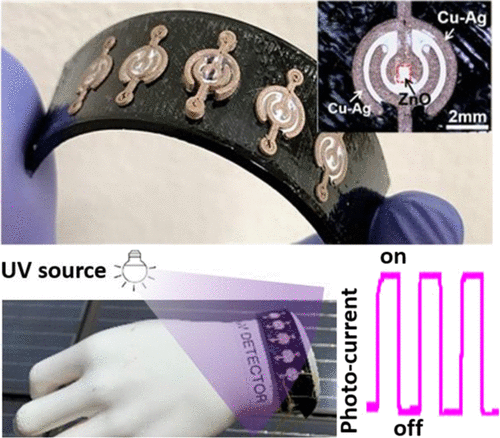Our official English website, www.x-mol.net, welcomes your feedback! (Note: you will need to create a separate account there.)
All 3D-Printed Flexible ZnO UV Photodetector on an Ultraflat Substrate.
ACS Sensors ( IF 8.9 ) Pub Date : 2020-03-23 , DOI: 10.1021/acssensors.9b02544 Dongil Lee 1, 2 , Myeong-Lok Seol 1, 2 , Gabrielle Motilal 1 , Beomseok Kim 1, 2 , Dong-Il Moon 1, 2 , Jin-Woo Han 1, 2 , M Meyyappan 1
ACS Sensors ( IF 8.9 ) Pub Date : 2020-03-23 , DOI: 10.1021/acssensors.9b02544 Dongil Lee 1, 2 , Myeong-Lok Seol 1, 2 , Gabrielle Motilal 1 , Beomseok Kim 1, 2 , Dong-Il Moon 1, 2 , Jin-Woo Han 1, 2 , M Meyyappan 1
Affiliation

|
An all three-dimensional (3D)-printed flexible ZnO ultraviolet (UV) photodetector is demonstrated, where the 3D-printing method is used not only for the electrode and photosensitive material but also for creating a substrate. An ultraflat and flexible substrate capable of serving as the backbone layer is developed using a water-dissolvable polymer layer for surface planarization. A two-layered printing followed by surface treatment is demonstrated for the substrate preparation. As mechanical support but flexible, a thick and sparse thermoplastic polyurethane layer is printed. On its surface, a thin and dense poly(vinyl alcohol) (PVA) is then printed. A precise control of PVA reflow using a microwater droplet results in a flexible and extremely uniform substrate. A Cu-Ag nanowire network is directly 3D printed on the flexible substrate for the conducting layer, followed by ZnO for the photosensitive material. Unlike the planar two-dimensional printing that provides thin films, 3D printing allows the electrode to have a step height, which can be made like a dam to accommodate a thick film of ZnO. Photosensitivity as a function of various ZnO thickness values was investigated to establish an optimal thickness for UV response. The device was also tested in natural sunlight along with stability and reliability.
中文翻译:

超薄基板上的所有3D打印的柔性ZnO UV光电探测器。
演示了全三维(3D)打印的柔性ZnO紫外(UV)光电探测器,其中3D打印方法不仅用于电极和光敏材料,而且用于创建基板。使用可溶于水的聚合物层对表面进行平坦化处理,从而开发出能够用作主干层的超平柔性基板。演示了用于基材制备的两层印刷,然后进行表面处理。作为机械支撑但有弹性,印刷了厚而稀疏的热塑性聚氨酯层。然后在其表面上印刷稀薄的聚乙烯醇(PVA)。使用微水滴对PVA回流进行精确控制可产生柔性且极其均匀的基材。将Cu-Ag纳米线网络直接3D打印在用于导电层的柔性基板上,然后将ZnO用于感光材料。与提供薄膜的平面二维打印不同,3D打印允许电极具有台阶高度,可以像坝一样将其制成以容纳ZnO的厚膜。研究了作为各种ZnO厚度值函数的光敏性,以建立紫外线响应的最佳厚度。该设备还经过了自然光以及稳定性和可靠性的测试。研究了作为各种ZnO厚度值函数的光敏性,以建立紫外线响应的最佳厚度。该设备还经过了自然光以及稳定性和可靠性的测试。研究了作为各种ZnO厚度值函数的光敏性,以建立紫外线响应的最佳厚度。该设备还经过了自然光以及稳定性和可靠性的测试。
更新日期:2020-03-23
中文翻译:

超薄基板上的所有3D打印的柔性ZnO UV光电探测器。
演示了全三维(3D)打印的柔性ZnO紫外(UV)光电探测器,其中3D打印方法不仅用于电极和光敏材料,而且用于创建基板。使用可溶于水的聚合物层对表面进行平坦化处理,从而开发出能够用作主干层的超平柔性基板。演示了用于基材制备的两层印刷,然后进行表面处理。作为机械支撑但有弹性,印刷了厚而稀疏的热塑性聚氨酯层。然后在其表面上印刷稀薄的聚乙烯醇(PVA)。使用微水滴对PVA回流进行精确控制可产生柔性且极其均匀的基材。将Cu-Ag纳米线网络直接3D打印在用于导电层的柔性基板上,然后将ZnO用于感光材料。与提供薄膜的平面二维打印不同,3D打印允许电极具有台阶高度,可以像坝一样将其制成以容纳ZnO的厚膜。研究了作为各种ZnO厚度值函数的光敏性,以建立紫外线响应的最佳厚度。该设备还经过了自然光以及稳定性和可靠性的测试。研究了作为各种ZnO厚度值函数的光敏性,以建立紫外线响应的最佳厚度。该设备还经过了自然光以及稳定性和可靠性的测试。研究了作为各种ZnO厚度值函数的光敏性,以建立紫外线响应的最佳厚度。该设备还经过了自然光以及稳定性和可靠性的测试。


























 京公网安备 11010802027423号
京公网安备 11010802027423号